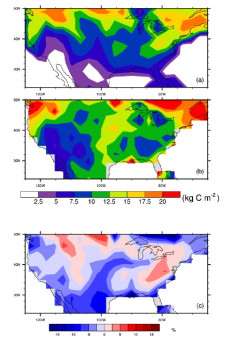Land Management Practices More Critical as Biofuels Use Grows
Climate Simulations Run at NERSC Show Cultivation Causes Carbon Loss in Soil
August 3, 2015
Angela Hardin, (630) 252-5501, media@anl.gov

(a) Total SOC simulated by CLM-Crop over the contiguous United States. (b) Total SOC from the IGBP over the same domain as in (a). (c) Percent difference between (a) and (b).
The handling of agricultural crop residues appears to have a large impact on soil's ability to retain carbon, making land management practices increasingly important, especially under a scenario where cellulosic materials become more heavily used as a feedstock for ethanol production, according to a study led by researchers at the U.S. Department of Energy’s Argonne National Laboratory.
“Plants and soil are carbon sinks,” said Argonne climate scientist Beth Drewniak, who led the study. “Soils lock carbon away for long periods of time. But when plant residues are harvested, not only are inputs of carbon and other nutrients to soil lost, but decomposition is accelerated, causing soils to lose additional carbon.”
That fact becomes significant as the nation moves closer to a codified federal target of producing 136 billion liters of renewable fuels by 2022, of which 61 billion liters is expected to come from cellulosic ethanol, according to the U.S. Environmental Protection Agency.
Cellulosic biomasses are important alternatives to conventional ethanol feedstock like corn, which may actually increase greenhouse gas emissions. Moreover, U.S. production of corn will be insufficient to meet large-scale demand for biofuels.
Carbon’s retention in soil helps keep carbon dioxide out of the air. Lands where conventional crops like corn and soybeans have been cultivated for extended periods have lost up to 65 percent of so-called soil organic carbon (SOC) when compared to grassland sites with their native vegetation intact, said Drewniak, corresponding author of the paper, which was published April 9, 2015, in the journal Biogeosciences.
While more modest carbon losses occurred when a greater percentage of the residue remained in the field, SOC increased by 2.6 percent when 90 percent of harvest residue is returned to the soil.
The study's results were generated using the Community Land Model (CLM)-Crop and are comparable to findings from physical studies. The CLM is a computer-modeling tool used to explore how land use and management techniques, including plant variety and fertilizer application, impact soil carbon levels at regional and global scales. CLM-Crop is used to examine the impact of land management practices on SOC storage in croplands in the continental United States during a 170-year period.
"Our simulations indicate that disturbance through cultivation will always result in a loss of soil carbon, and management practices will have a large influence on the magnitude of SOC loss," according to the paper.
For example, limiting or eliminating the use of fertilizer had the biggest impact on crop yields and SOC, combined. Fertilization, of course, increases yields, as well as the possibility to increase the amount of biomass returned to the soil as residue, allowing soil to keep nutrients absorbed during crop growth and improving the land's fertility.
Cellulosic biofuel production is expected to involve the use of crop residue—the stems and leaves of plants—but the increased use of residues for ethanol production could significantly reduce soil carbon storage capability, as well as plant productivity.
Soil is the Earth's single largest carbon storage container. With such an important role in the carbon storage cycle, it is critically important to understand how land management practices, beyond what is currently included in the CLM-Crops model, affect soil's carbon retention capability.
Funding for the study was provided by the Laboratory Directed Research and Development program.
This article is based on materials provided by Argonne National Laboratory.
About NERSC and Berkeley Lab
The National Energy Research Scientific Computing Center (NERSC) is a U.S. Department of Energy Office of Science User Facility that serves as the primary high performance computing center for scientific research sponsored by the Office of Science. Located at Lawrence Berkeley National Laboratory, NERSC serves almost 10,000 scientists at national laboratories and universities researching a wide range of problems in climate, fusion energy, materials science, physics, chemistry, computational biology, and other disciplines. Berkeley Lab is a DOE national laboratory located in Berkeley, California. It conducts unclassified scientific research and is managed by the University of California for the U.S. Department of Energy. »Learn more about computing sciences at Berkeley Lab.







